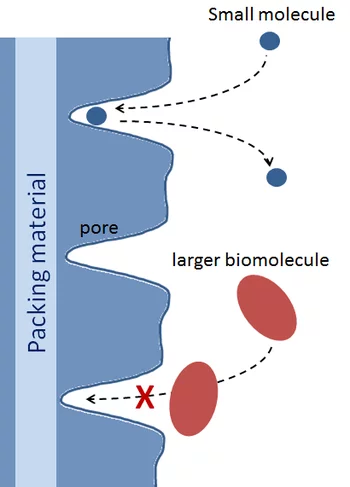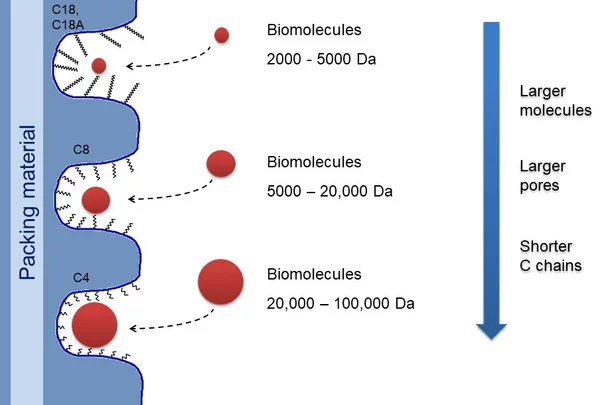-

Eurosil Bioselect: ideal for the denaturative separation of biomolecules
The Eurosil Bioselect stationary phase was specifically developed for the separation of proteins and peptides

The Eurosil Bioselect stationary phase was specifically developed for the separation of proteins and peptides
Strict manufacturing procedures ensure a very narrow pore size distribution. Interfering anions or heavy metal ions on the silica surface are not present in Eurosil Bioselect columns because only ultra pure silica gel and high quality chemical modifications are employed.
Eurosil Bioselect columns for HPLC feature a wide-pore (300 Å) stationary phase and were specifically designed to separate large biomolecules, such as proteins and peptides.
|
Silica gel |
ultra pure, > 99.99 % |
|
Metal content |
< 10 ppm |
|
Particle size |
3 μm, 5 μm, 10 μm (15 μm, 20 – 25 μm upon request) |
|
Particle form |
spherical |
|
Pore size |
100 Å |
|
Specific surface |
90 ± 5 m2/g |
|
Pore volume |
0.8 ml/g |
|
Density |
450 g/l |
To separate larger molecules, they need to freely access the interior of the pores of the packing material. Therefore, the analytes’ diameter must be smaller than the average pore diameter. For higher molecular weight solutes, the use of lower pore size materials (60-120 Å) as typically used for the analysis of small molecules may result restricted diffusion in the material´s pores and therewith reduced column efficiency.
The use of larger pore silica-based bonded phases leads to improvements in resolution, capacity and recovery of proteins and other biomolecules, due to a reduction in size exclusion mechanism and enhanced molecular diffusion rates. A pore size of 300 Å has become the accepted standard for wide pore silica gels because it has been found to be suitable for a broad range of molecular weight proteins, peptides and oligonucleotides. In general, peptides exceeding approximately 50 amino acids and oligonucleotides greater than 25 residues are preferentially analyzed on 300 Å materials.

The C4 modification is the most often used wide pore phase for the analysis of proteins, because most of them are well separated on these stationary phases. It is on the one hand more polar compared to a classical C8 or C18 phase caused by the lower carbon content and suited for even larger biomolecules up to around 100,000 Da caused by the shorter chain lengths of the modification and therewith larger pore sizes remaining after modification of the silica ground material.

With our focused range of four different surface modifications, the most important applications in reversed phase mode biochromatography are covered. All Eurosil Bioselect modifications offer high chemical stability and high loading capacity. KNAUER’s long experience and knowledge in producing HPLC columns ensures you of excellent batch reproducibility.
Eurosil Bioselect columns are particularly suitable for the separation of hydrophobic substances such as proteins. Very good results can also be obtained for separating oligonucleotides and for peptide mapping after enzyme digestion.
| Modification | USP code | Application area | Carbon % | pH range |
| C18 | L1 | hydrophilic biomolecules, peptides, peptide mapping after enzymatic digestion, biomolecules up to 5000 Da | 7.5 % (conventional endcapping) | 2 - 8 |
| C18 A | L1 | hydrophilic and polar biomolecules, peptides, very polar biomolecules separated with 100 % aqueous eluents, biomolecules up to 5000 Da | 7 % (hydrophilic endcapping) | 2 - 8 |
| C8 | L7 | very polar biomolecules up to 20,000 Da | 4.5 % (conventional endcapping) | 2 - 8 |
| C4 | L26 | biomolecules such as proteins, biomolecules up to about 100,000 Da | 2 % (conventional endcapping) | 2 - 8 |